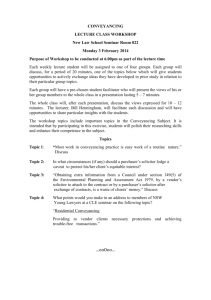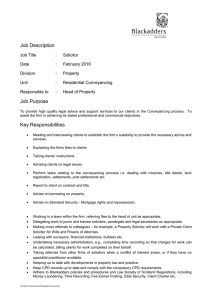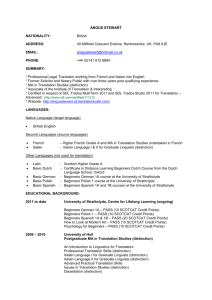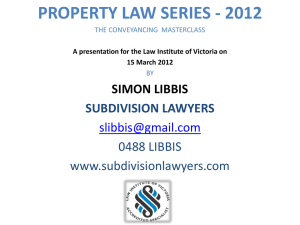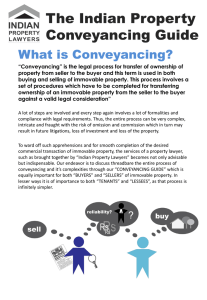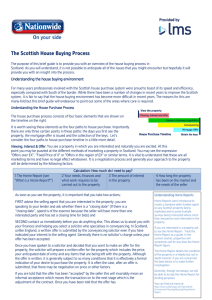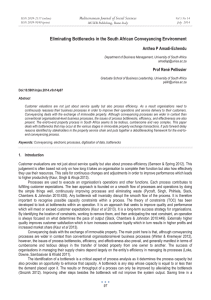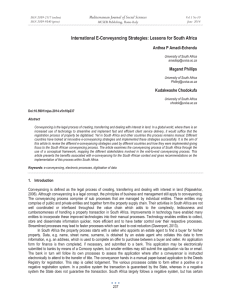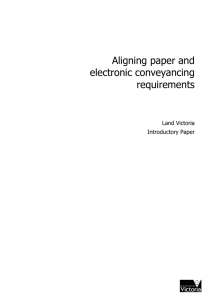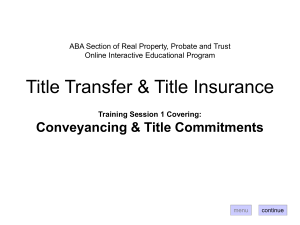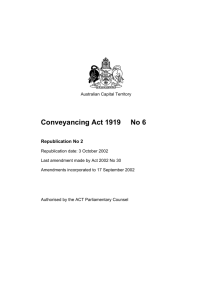Conveyancing Protocol: an update
advertisement
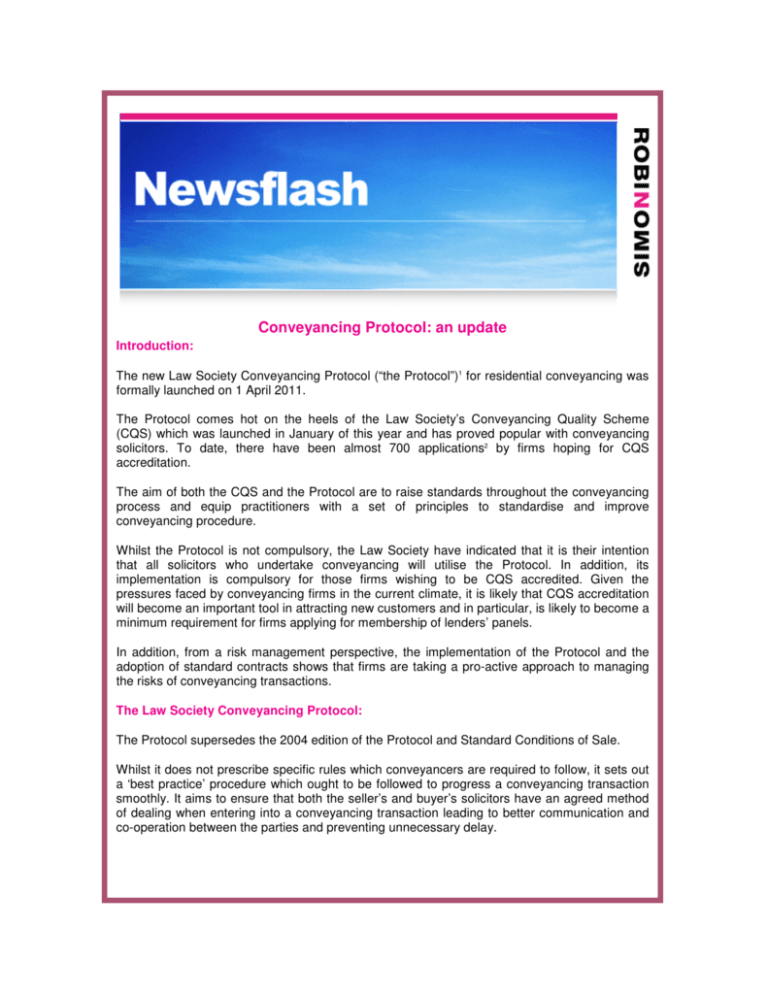
Conveyancing Protocol: an update Introduction: The new Law Society Conveyancing Protocol (“the Protocol”)1 for residential conveyancing was formally launched on 1 April 2011. The Protocol comes hot on the heels of the Law Society’s Conveyancing Quality Scheme (CQS) which was launched in January of this year and has proved popular with conveyancing solicitors. To date, there have been almost 700 applications2 by firms hoping for CQS accreditation. The aim of both the CQS and the Protocol are to raise standards throughout the conveyancing process and equip practitioners with a set of principles to standardise and improve conveyancing procedure. Whilst the Protocol is not compulsory, the Law Society have indicated that it is their intention that all solicitors who undertake conveyancing will utilise the Protocol. In addition, its implementation is compulsory for those firms wishing to be CQS accredited. Given the pressures faced by conveyancing firms in the current climate, it is likely that CQS accreditation will become an important tool in attracting new customers and in particular, is likely to become a minimum requirement for firms applying for membership of lenders’ panels. In addition, from a risk management perspective, the implementation of the Protocol and the adoption of standard contracts shows that firms are taking a pro-active approach to managing the risks of conveyancing transactions. The Law Society Conveyancing Protocol: The Protocol supersedes the 2004 edition of the Protocol and Standard Conditions of Sale. Whilst it does not prescribe specific rules which conveyancers are required to follow, it sets out a ‘best practice’ procedure which ought to be followed to progress a conveyancing transaction smoothly. It aims to ensure that both the seller’s and buyer’s solicitors have an agreed method of dealing when entering into a conveyancing transaction leading to better communication and co-operation between the parties and preventing unnecessary delay. The Protocol describes itself as a “conveyancing checklist”. It begins with 12 general obligations which are designed to remind practitioners of the standards expected of them, it also emphasises the overriding obligation to act in the best interests of the client, which takes precedence over the Protocol. The general obligations are:1 Disclose to the buyer/seller that there are professional obligations which apply to the sale and/or purchase. Obtain agreement and instructions to enable you to act in accordance with the terms and spirit of the Protocol. 2 Where acting for a lender as well as for a buyer/solicitor, the duties owed to the lender are no less important than they are for any buyer/seller, subject to the nature of the instruction. 3 There is potential for a conflict of interest to arise when acting for more than one party; sellers, buyers and lenders. Careful consideration must be given to this. 4 Endeavour to maintain vigilance to protect and guard against fraudulent or other illegal behaviour encountered in the conveyancing process. 5 Maintain high standards of courtesy and deal with others in a fair and honest manner. 6 Co-operate with others and treat them with respect. 7 Share information with others to assist in the efficient management of each transaction or change of transaction. Requirements to provide and share information at each stage of the Protocol are subject to client confidentiality obligation. If the borrower/seller consents to the disclosure of information about the transaction/other transactions in the chain and/or change in circumstances, this information should be disclosed. The buyer/seller should not be encouraged to withhold authority to disclose information unless there are exceptional circumstances. 8 Respond to all communications promptly or in accordance with agreed timeframe. Where something is to be addressed in a different order or by different means, this should be notified to those who are affected as soon as reasonably possible. Steps required by the Protocol should be carried out as soon as reasonably possible. 9 Deal with transaction materials including correspondence, electronic or otherwise, efficiently and with care and consideration. Where parties agree to deal on line, agree arrangements, for example, to acknowledge receipt. Where documents are submitted by post, submit draft documents in duplicate. 10 Ensure all incoming data is loaded on to the system and made available to the person dealing within a day of receipt, where any automated data handling or scanning of documents is used. 11 Use the most up to date version of forms, formulae and codes provided by the Law Society. Follow the advice contained in SRA, guidance, Law Society practice notes and other practice information. Update forms to accord with changes in the law if these have not been updated by the Law Society. 12 Ensure proper arrangements are made for file management (including cover for absent colleagues) during any period of planned or unplanned absence. In addition, the Protocol requires the use of a Standard Form of Contract and updates the Standard Conditions of Sale (5th Edition) accordingly. In terms of procedure to be followed, there are unlikely to be any surprises for conveyancers. One of the more significant changes, which is likely to be welcomed by conveyancers, is that risk now passes to the buyer on exchange of contracts, rather than on completion. The other changes are generally subtle but important, for example one requirement is for the seller’s solicitor to update the register when submitting a contract. In addition, it is hoped that a by-product of the Protocol will be a reduction in fraud and money laundering in property transactions. The Protocol should prompt conveyancers to be especially vigilant when undertaking client identity and money laundering checks. Standard Conditions of Sale: Some of the more significant changes are to the Standard Conditions of Sale (“SCS”). In the past, conveyancers could adopt any contract they considered appropriate for a particular transaction. Not only did the Law Society produce Standard Conditions of Sale, but regional law societies often had their own amended versions and there were likely to be significant special conditions added to contracts. That not only led to confusion and delay, but in some cases, solicitors have been found negligent for failing to advise their client on the terms of a contract, particularly when there have 3 been special conditions incorporated by the other party. In Sykes v Midland Bank the solicitors were found to be in breach of duty for failing to advise on an unusual condition in a leasehold contract which lead to their client being unable to sublet the premises. The changes to the SCS are aimed at reducing the number of amendments that are routinely made by the parties. Point 34 of the Protocol states, “the use of standard additional enquiries may constitute a breach of this Protocol”. In that regard, the Protocol is clear in that it no longer permits the addition of any ‘special’ conditions unless they are absolutely necessary for the particular transaction. Risk Management: Although the Protocol is not intended to extend a conveyancers duty of care to their client, the reality is that any departure from the obligations may be considered evidence of a breach of duty in any professional negligence claim. Equally, if a conveyancer can show that they have followed the ‘best practice’ procedure set out in the Protocol, and incorporated the standard 4 conditions of contract, they are at much lower risk of a finding of breach of duty . In addition, the adoption of ‘best practice’ procedures such as the Protocol are likely to be viewed positively by Professional Indemnity Insurers, who see pro-active risk management as key to evaluating the risk of insuring particular firms. Conclusion: The Protocol is an extremely accessible guide to the steps which ought to be followed to complete a residential conveyancing transaction. Whilst the Protocol is a voluntary framework which the parties can, at present, choose to ignore, it is hoped by the Law Society that the Protocol and standard conditions of sale will be adopted by all conveyancers in order to standardise and streamline the procedure, and improve consumer confidence in the conveyancing process. In addition, a greater degree of standardisation ought to reduce the risk of mistakes being made and claims against conveyancers. 1 2 3 4 http://www.lawsociety.org.uk/new/documents/accreditation/cqs-protocol.pdf Law Society Gazette – Making the grade: examining accreditation schemes – 31 March 2011 Sykes v Midland Bank Executor & Trustee Company [1971] 1 QB 113 & Boateng & Hughmans [2002] EWCA Civ 593 Walker v Boyle [1982] WLR 495 where it was held that it was “perfectly normal and proper for a solicitor to use standard conditions of sale…I do not think he is called on to go through the small print of those somewhat lengthy conditions with a toothcomb”. Should you require any further information please contact: Judy Gibson/Jenny Drever T +44 (0)333 010 5952 / 5927 F +44 (0)333 010 0005 E judy.gibson@robinsimonllp.com / jennifer.drever@robinsimonllp.com We can put together a seminar/talk or panel discussion on the issue above, or any of the issues featured in our publications to be held at any of our offices, or yours. If you are interested, please contact any one of our lawyers or David Simon at: david.simon@robinsimonllp.com London Minster House 42 Mincing Lane London EC3R 7AE T +44(0)333 010 0000 F +44(0)333 010 0001 Leeds 2 St David's Court David Street Leeds LS11 5Q T +44(0)333 010 0000 F +44(0)333 010 0003 Manchester 80 Mosley Street St Peter’s Square Manchester M2 3FX T +44(0)333 010 0000 F +44(0)333 010 0006 Birmingham 37a Waterloo Street Birmingham B2 5TJ T +44(0)333 010 0000 F +44(0)333 010 0005 E info@robinsimonllp.com W www.robinsimonllp.com Terms | Privacy Policy | Unsubscribe These brief articles and summaries should not be applied to any particular set of facts without seeking legal advice. Robin Simon LLP is a Limited Liability Partnership registered in England and regulated by the Solicitors Regulation Authority. Its registered office is at 2 St David’s Court, David Street, Leeds LS11 5QA. Registered number OC304019 The Members may also be referred to in correspondence as “partners” in Robin Simon LLP. Copyright © 2011 Robin Simon LLP
